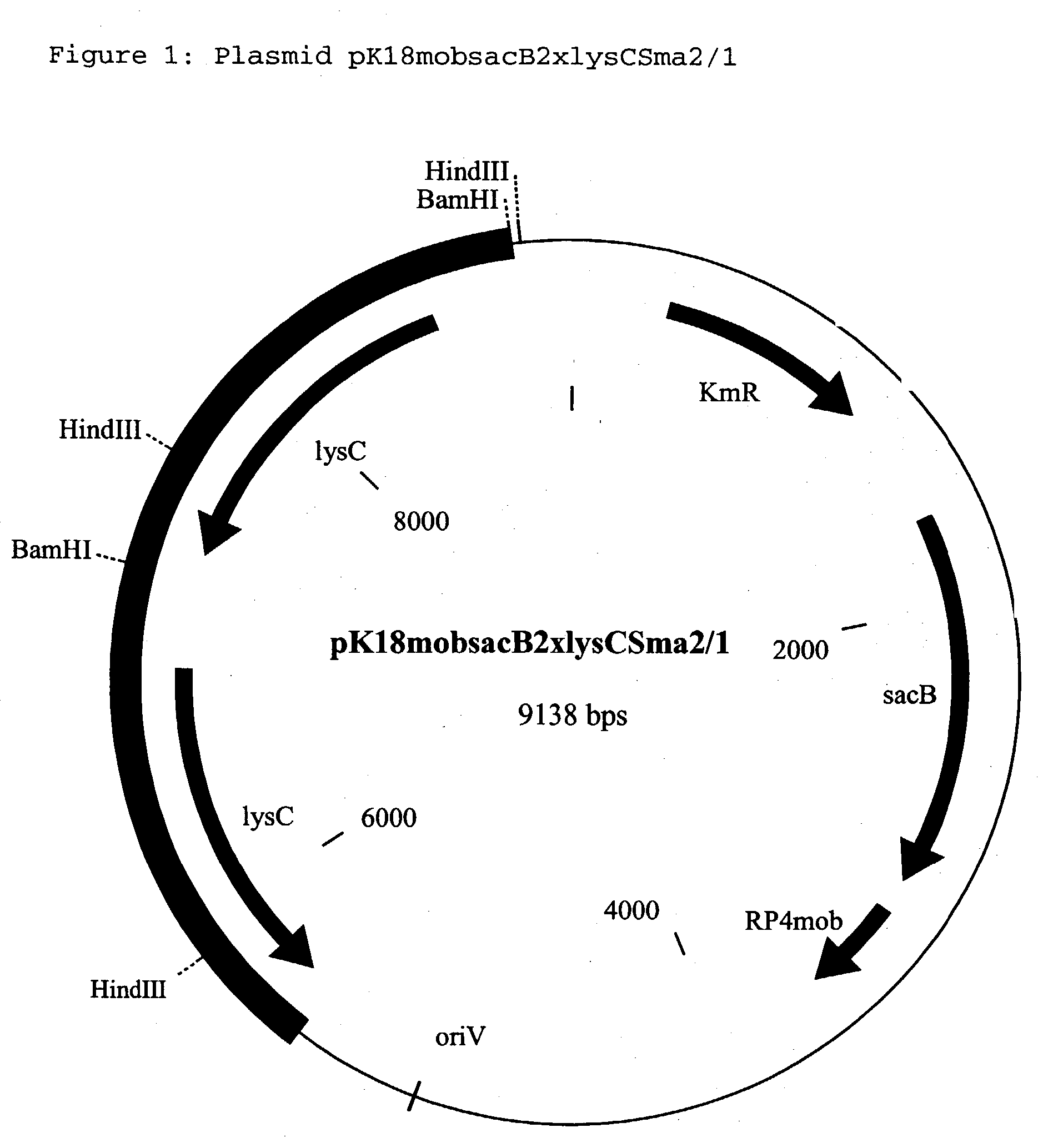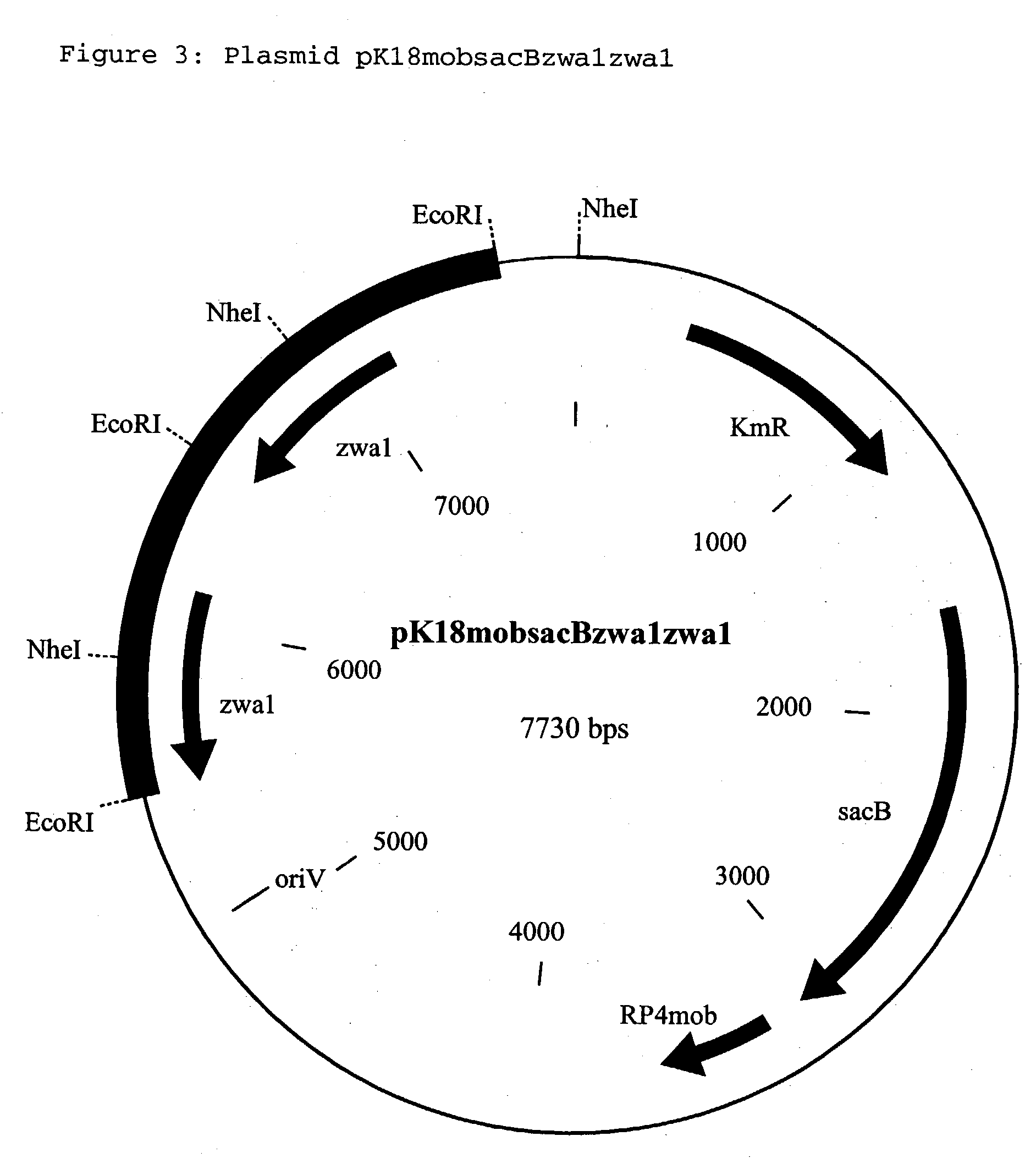Coryneform bacteria which produce chemical compounds II
- Summary
- Abstract
- Description
- Claims
- Application Information
AI Technical Summary
Benefits of technology
Problems solved by technology
Method used
Image
Examples
example 2
[0242] Generation of a Tandem Duplication of the lysE Gene in the Chromosome of Corynebacterium glutamicum
[0243] 2.1. Construction of the Tandem Vector pK18mobsacB2xlysESma1 / 1
[0244] Plasmid DNA was isolated from the Escherichia coli strain DSM12871 (EP-A-1067193), which carries the plasmid pEC7lysE.
[0245] The plasmid contains the lysE gene which codes for lysine export. A pure culture of this strain was deposited on Jun. 10, 1999 at the Deutsche Sammlung fur Mikroorganismen und Zellkulturen (DSMZ, Braunschweig, Germany) in accordance with the Budapest Treaty.
[0246] The plasmid pEC71lysE is cleaved with the restriction enzyme BamHI (Amersham-Pharmacia, Freiburg, Germany), after separation in an agarose gel (0.8%) the lysE fragment of approx. 1.1 kb is isolated from the agarose gel with the aid of the QIAquick Gel Extraction Kit (Qiagen, Hilden, Germany), and the overhanging ends are completed with Klenow polymerase (Boehringer Mannheim) and employed for ligation with the mobilizable ...
example 3
[0263] Generation of a Tandem Duplication of the zwa1 Gene in the Chromosome of Corynebacterium glutamicum
[0264] 3.1. Construction of the tandem vector pK18mobsacBzwa1zwa1
[0265] Plasmid DNA was isolated from the Escherichia coli strain DSM13115 (EP-A-1111062), which carries the plasmid pCR2.1zwa1exp.
[0266] The plasmid contains the zwa1 gene which codes for cell growth factor 1. A pure culture of this strain was deposited on Oct. 19, 1999 at the Deutsche Sammlung fur Mikroorganismen und Zellkulturen (DSMZ, Braunschweig, Germany) in accordance with the Budapest Treaty.
[0267] The plasmid pCR2.1zwa1exp is cleaved with the restriction enzyme EcoRI (Amersham-Pharmacia, Freiburg, Germany), and after separation in an agarose gel (0.8%) the zwa1 fragment of 1 kb is isolated from the agarose gel with the aid of the QIAquick Gel Extraction Kit (Qiagen, Hilden, Germany) and employed for ligation with the mobilizable cloning vector pK18mobsacB described by Schafer et al., Gene, 14, 69-73 (1994)....
example 4
[0281] Preparation of Lysine
[0282] The C. glutamicum strains DSM13992lysC.sup.FBR::lysC.sup.FBR, ATCC21513.sub.--17lysE::lysE and ATCC21513.sub.--17zwa1::zwa1 obtained in Examples 1 to 3 are cultured in a nutrient medium suitable for the production of lysine and the lysine content in the culture supernatant was determined.
[0283] For this, the strains are first incubated on an agar plate for 24 hours at 33.degree. C. Starting from this agar plate culture, a preculture is seeded (10 ml medium in a 100 ml conical flask). The medium MM is used as the medium for the preculture. The preculture is incubated for 24 hours at 33.degree. C. at 240 rpm on a shaking machine. A main culture is seeded from this preculture such that the initial OD (660 nm) of the main culture is 0.1 OD. The Medium MM is also used for the main culture.
[0284] Medium MM
19 CSL 5 g / l MOPS 20 g / l Glucose (autoclaved separately) 50 g / l Salts: (NH.sub.4).sub.2SO.sub.4 25 g / l KH.sub.2PO.sub.4 0.1 g / l MgSO.sub.4 * 7 H.sub.2O...
PUM
| Property | Measurement | Unit |
|---|---|---|
| Fraction | aaaaa | aaaaa |
| Volume | aaaaa | aaaaa |
| Volume | aaaaa | aaaaa |
Abstract
Description
Claims
Application Information
 Login to View More
Login to View More - R&D
- Intellectual Property
- Life Sciences
- Materials
- Tech Scout
- Unparalleled Data Quality
- Higher Quality Content
- 60% Fewer Hallucinations
Browse by: Latest US Patents, China's latest patents, Technical Efficacy Thesaurus, Application Domain, Technology Topic, Popular Technical Reports.
© 2025 PatSnap. All rights reserved.Legal|Privacy policy|Modern Slavery Act Transparency Statement|Sitemap|About US| Contact US: help@patsnap.com



